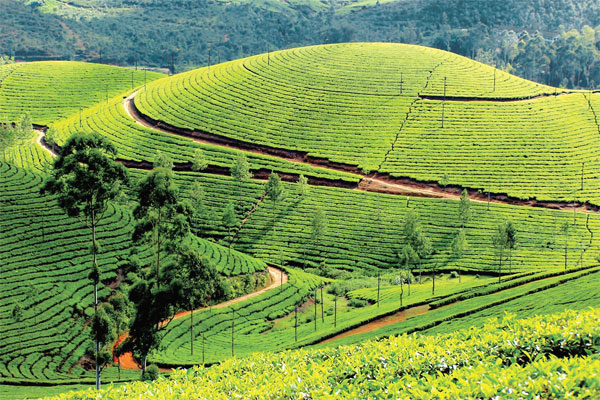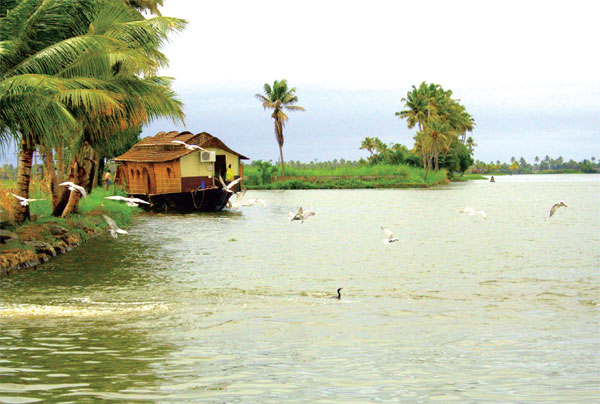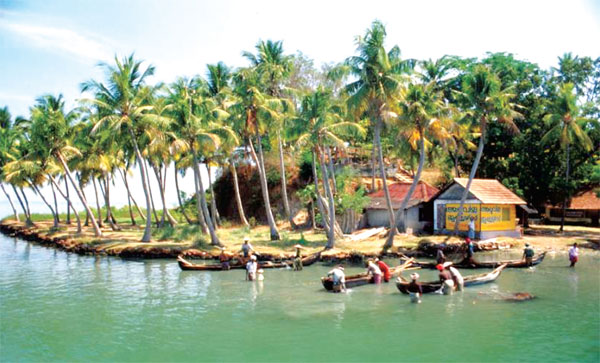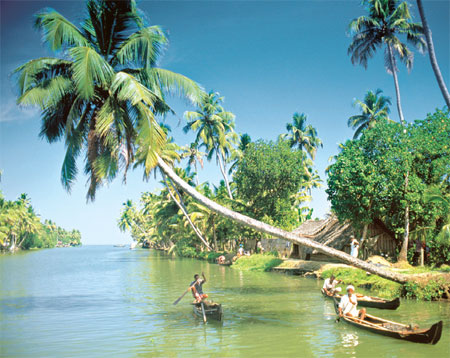A glimpse of Kerala
As grandiose slogans go, Kerala has one of the best: "God's own
country," they call it, an assertion of divine provenance that's loudly
proclaimed on countless signposts and bumper stickers across the state.
In this prosperous state on the southwest coast of India, the slogan
doesn't sound smug so much as sincere, precise even. "Rest your eyes on
our natural splendour," it seems to say, "and believe."
 The phrase invokes the stunning natural beauty for which Kerala is
renowned, of course, but also alludes to the variety of faiths that
thrive here: The coexistence of Hindus, Muslims, Christians and even
some Jains is apparent in the busy juxtaposition of towers, minarets and
spires that sit cheek by jowl in every city, town and village. If for no
other reason, the state can lay claim to the title of "God's own
country" because there are so many gods who might be inclined to choose
it as their own. The phrase invokes the stunning natural beauty for which Kerala is
renowned, of course, but also alludes to the variety of faiths that
thrive here: The coexistence of Hindus, Muslims, Christians and even
some Jains is apparent in the busy juxtaposition of towers, minarets and
spires that sit cheek by jowl in every city, town and village. If for no
other reason, the state can lay claim to the title of "God's own
country" because there are so many gods who might be inclined to choose
it as their own.
The Fort Kochi, a famously quaint heritage city filled with the
vestiges of its Portuguese, Dutch and British colonial past. From the
stunning beaches along the Malabar Coast to the maze of backwater canals
cutting through huge rice fields to the glorious rolling hillside tea
plantations in the Western Ghats, Kerala's landscapes are almost as
diverse as its people.
But the most abiding quality of those landscapes is the way they
unfold in varying shades of lush green, as though the colour spectrum
had been forced to expand to accommodate the state's spectacular
fertility.
The name Kerala is derived from kera, the local Malayalam word for
coconut, and there is an abundance of palm trees across the state, the
spiky dark green fronds acting as natural parasols against the glare of
the sun.
The coconut doesn't just lend its name to the place, but also acts as
a ubiquitous and adaptable natural resource from which countless
products, such as coir, a versatile fibre, and toddy, a famous - and
potent - local brew, are derived.
Mountains of tea
It's the plant behind another beverage that gives the area around the
hill station town of Munnar, in east Kerala, its famously vibrant shade
of green. In this part of the Western Ghats mountain region, the steep
hillsides are covered with about 60,000 acres of tea plantations - an
industry begun by the British, who established the plantations in the
late 19th century.

The result is a stunning vista: The vast swaths of tea bushes cling
to the hills like a soft emerald carpet. The narrow pathways between the
bushes, the trails followed by the tea pickers, lead to patterned
grooves accentuating the topography.
The emerald sheen of the hillsides comes courtesy of the empire's
insatiable appetite for tea.
As a town, Munnar has been blighted by thoughtless over development,
with large hotels springing up in shambolic fashion.
But traces of its history as a hill station, or colonial mountain
town, remain, such as a few Christian churches and the High Ranges club,
the latter persevering as if the sun had never fully set on the empire.
Grasses and goats
The treetops and tea plantations are arrayed on the hillsides below
and from here you get an unrivalled view of the rolling countryside,
with pockets of mist occupying some valleys while occasional
lost-looking clouds skim the highest peaks. Looming over the reserve is
Anaimudi mountain, which, at 8,842 feet, is the highest mountain in
southern India. It's a forbidding hunk of rock, earning the nickname
Elephant Head with its imposing outline.
One of the chief attractions of Eravikulam is the Nilgiri tahr, a
rare mountain goat that was nearly extinct a century ago but now numbers
approximately 3,000, about half of them in this reserve.
Unlike the wild elephants that you can glimpse in certain wide
pastures in the valleys below, the Nilgiri tahr are happy to approach
the pathway, mingling with visitors in nonchalant fashion.
In the backwaters
 Quite another shade of green characterises the famous Kerala
backwaters near the coast. Quite another shade of green characterises the famous Kerala
backwaters near the coast.
Although the tea plantations are closer to emerald, the vast rice
paddies of this area are an almost luminous jade, fringed with palm
trees and banana plants.
The wetlands area around Kuttanad is a dense maze of canals, rivers
and lake, largely south of the Vembanad lake, one of the largest in
India.
The mythology has it that Kerala was created when Parasurama, an
incarnation of Vishnu, threw his battle axe into the sea, resulting in
this conflicted countryside, neither all water nor all land.
A voyage along the backwaters on one of the traditional thatched
boats is one of the quintessential Kerala experiences; the kettuvallam,
as they are known, were once used to carry rice and passengers around
the waterways and are now being adapted as houseboats, many extremely
luxurious.
They come in all shapes and sizes, the roofs usually bowed, curving
gracefully toward the water.
The contrast with the waterways couldn't be starker. Once you're on
the water, the delirium of Alleppey fades to a dim memory, replaced by a
pervasive calm.
A cruise along the canals is captivating - so serene, so tranquil
that it weaves a kind of meditative spell, like a deep-tissue massage
for the soul.

The quotidian charms of local life here - the beautiful little
cottages along the waterways, with moored boats instead of parked cars;
small shops and toddy bars; numerous churches, some daringly modern in
style, others tracing their roots back to the time of St. Thomas, the
doubting apostle, who is said to have arrived in these parts in the 1st
century.
- Internet |

